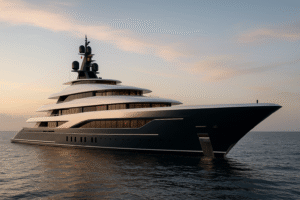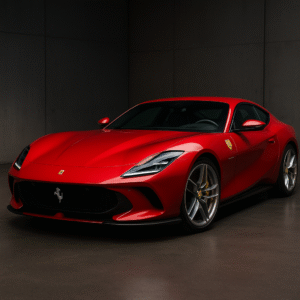When Eric Clapton asks Ferrari to build him a car that exists nowhere else on Earth, Maranello listens. The guitarist’s custom SP12 EC—produced through Ferrari’s One-Off division—signalled a wider truth about high-end consumption: for the ultra-rich, the brand name on the bonnet is only the opening line. What really confers status in 2025 is non-fungibility—objects so tailored to their owner that no two Instagram feeds can show the same thing. From hyper-personalised supercars to yachts launched on a scaffold of champagne and tricolour smoke, bespoke everything is eclipsing badge worship.
The data behind the desire
Personalisation has moved from marketing flourish to bottom-line engine. Ferrari tells investors that bespoke options add roughly 30 % to the ticket price of a new car—one reason the company’s Q1 2025 operating profit climbed 23 % year-on-year despite flat global deliveries. Rolls-Royce goes further, crediting its Bespoke Collective—an in-house guild of artisans in Goodwood—with the majority of revenue growth as its average transaction value now sits north of £500,000. In other words: uniqueness is the new volume.
Four wheels, infinite possibilities
Ferrari offers a three-tier menu—Atelier, Tailor Made and the invitation-only One-Off programme—where clients can spend hours experimenting with vintage leathers, heritage paint codes and 3-D-printed titanium badges. Design chief Flavio Manzoni says the firm will not flood the road with one-offs; scarcity is the point. Rolls-Royce takes the opposite tack of proliferating Private Offices in Los Angeles, Dubai and soon Shanghai, mini-studios where patrons co-create everything from galaxy-mapped Starlight headliners to embroidered family crests that ripple across door cards.
What unites these marques is a pivot away from industrial scale toward artisanal margin. Bespoke paint processes alone can run 10 layers deep, and clients frequently pay more for pigment than for a well-equipped BMW. The result is a product that doubles as a rolling biography—part mechanical engineering, part memoir.
When your driveway floats
On May 22 the 72-metre Big Naan slid into the water at Columbus Yachts’ Savona yard, its owners saluted by plumes of red-white-green smoke. The vessel’s twin MTUs promise 39 knots, but top speed is not the headline; so are its fold-out terraces cantilevered to catch sunsets at anchor. Custom yachts have become the open-sea equivalent of private compounds, and European yards are racing to compress build times. Oceanco’s new Simply Custom platform offers a catalogue of hulls that can be finished to breathtaking individual briefs—think floating wellness suites and on-board NFT galleries—yet delivered 30 % faster than a traditional full-custom project.
Inside, 2025 design cues skew toward sustainability wrapped in opulence: reclaimed walnut alongside back-lit onyx, or smart-glass panels that flip from clear to opaque with a voice command. The message is that personal expression and planetary conscience can, at least for those with unlimited budgets, live in the same square metre.
One-of-one beyond mobility
The appetite for singularity is spreading well beyond vehicles. High-jewellery maisons now create “secret archives” of stones, accessible only to their top twenty clients, while independent watchmakers like Greubel Forsey allocate entire production runs to collector-specified dial colours. Even pets are demanding bespoke treatment: £15,000 dog-wash stations and teak-decked catwalks are being built into new-build mansions and yachts alike.
Meanwhile RM Sotheby’s is taking the concept of one-off to the auction block. Tomorrow’s Crown Jewel sale in Monte-Carlo will offer Michael Schumacher’s 2001 Ferrari F2001 track-side during the Grand Prix—an experience so tailored that bidders can hear the live wail of modern F1 cars while raising a paddle.
Why uniqueness beats brand noise
Several forces fuel the bespoke boom:
- Social saturation – In a world where every Hermès bag has a hashtag, the ultra-rich seek objects that cannot be Googled.
- Emotional ROI – Co-creation turns consumption into narrative; customers feel they’ve stamped identity onto steel and leather.
- Financial resilience – One-offs often appreciate; a unique Ferrari or superyacht can become an asset class that hedges against the commoditisation of mainstream luxury.
- Technological enablement – 3-D printing, VR design studios and blockchain provenance make exclusive production both faster and more transparent.
Lessons for luxury brands
For companies, bespoke is less a trend than a supply-chain revolution. Keeping pace means:
- Flexible manufacturing – Micro-batch paint lines, modular architecture and digital twins that let a client “walk” through their yacht months before a keel is laid.
- Craft retention – Brands are investing in artisan guilds to preserve embroidery, marquetry and stone-setting skills that machines still can’t replicate.
- Experience ecosystems – Ferrari’s private track days and Rolls-Royce’s art residencies deepen the bond long after delivery day, turning buyers into lifelong patrons.
The road (and sea, and sky) ahead
As wealth concentrates and social media accelerates the search for differentiation, bespoke luxury shows no sign of slowing. The ultra-rich aren’t rejecting brands; they’re demanding that brands hand over the creative reins. Status, once measured in logos, is now quantified in how impossible an object is to replicate. If luxury in the 20th century was about owning what few could afford, luxury in the quarter-century ahead is about owning what no-one else can even order.






